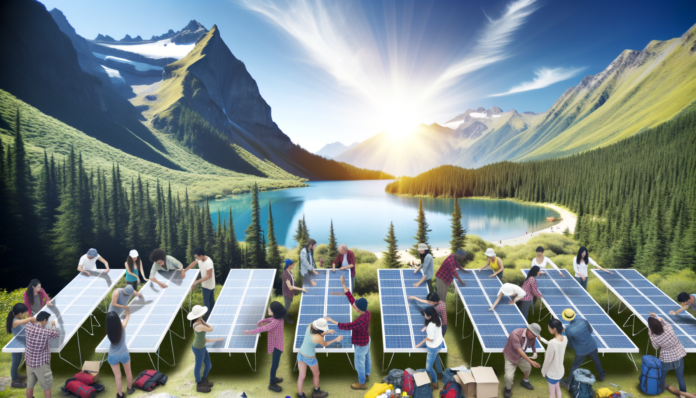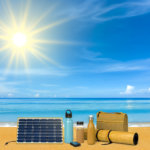Introduction
The Growing Need for Sustainable Energy
In today’s world, the urgency for sustainable energy solutions has never been more pronounced. With the escalating concerns over climate change, dwindling fossil fuel reserves, and the environmental impact of traditional energy sources, the shift towards renewable energy is not just a trend but a necessity. Solar energy, in particular, stands out as a clean, renewable source that can significantly reduce our carbon footprint and contribute to a healthier planet. By harnessing the power of the sun, we can generate electricity without emitting greenhouse gases, thus mitigating the adverse effects of climate change.
Why Solar Power is Ideal for Adventurers
For outdoor enthusiasts and adventurers, solar power offers a unique set of advantages that make it an ideal energy source. Whether you’re camping in the wilderness, hiking through remote trails, or sailing across the seas, access to reliable power can be a game-changer. Traditional power sources like batteries and generators come with limitations such as weight, fuel dependency, and environmental impact. In contrast, solar panels provide a lightweight, portable, and eco-friendly solution that can keep your devices charged and your adventures powered.
- Portability: Modern solar panels are designed to be lightweight and easy to carry, making them perfect for outdoor activities.
- Independence: With solar power, you are not reliant on fuel or electricity grids, giving you the freedom to explore off-the-beaten-path locations.
- Eco-Friendly: Solar panels generate clean energy, reducing your environmental impact and allowing you to enjoy nature responsibly.
Overview of Next-Gen Solar Panels
The evolution of solar panel technology has brought about significant advancements, leading to the development of next-gen solar panels that are more efficient, durable, and versatile than ever before. These innovations are particularly beneficial for adventurers who require reliable and robust energy solutions in diverse and often challenging environments.
- Increased Efficiency: Next-gen solar panels boast higher efficiency rates, meaning they can convert more sunlight into usable electricity, even in low-light conditions.
- Durability: Built to withstand harsh weather conditions, these panels are designed with rugged materials that ensure longevity and reliability.
- Portability: Advances in design have led to the creation of flexible and foldable panels that are easy to transport and set up, making them ideal for outdoor use.
In summary, the growing need for sustainable energy, coupled with the unique advantages of solar power for adventurers, underscores the importance of next-gen solar panels. These cutting-edge technologies not only provide a reliable and eco-friendly power source but also enhance the overall experience of outdoor adventures, making them more sustainable and enjoyable.
The Evolution of Solar Panel Technology
From Traditional to Next-Gen: A Brief History
The journey of solar panel technology began in the early 19th century when French physicist Edmond Becquerel discovered the photovoltaic effect in 1839. This phenomenon, where certain materials generate an electric current when exposed to light, laid the groundwork for modern solar cells. The first practical photovoltaic cell was developed in 1954 by Bell Labs, marking the inception of solar energy as a viable power source.
Initially, solar panels were primarily used in space applications, providing power for satellites. Over the decades, advancements in materials and manufacturing processes have significantly reduced costs and improved efficiency, making solar panels accessible for residential, commercial, and industrial use. Today, next-gen solar panels are at the forefront of sustainable energy solutions, offering enhanced performance and versatility for a wide range of applications.
Key Innovations in Modern Solar Panels
The evolution of solar panel technology has been driven by several key innovations:
- Material Advancements: The shift from traditional silicon-based cells to advanced materials like perovskite and organic photovoltaics has opened new possibilities for higher efficiency and lower production costs.
- Multi-Junction Cells: These cells use multiple layers of different semiconductor materials to capture a broader spectrum of sunlight, significantly boosting efficiency.
- Bifacial Panels: Unlike traditional panels that capture sunlight on one side, bifacial panels can absorb light from both sides, increasing energy yield.
- Flexible and Lightweight Designs: Innovations in materials have led to the development of flexible and lightweight solar panels, ideal for portable and off-grid applications.
- Integrated Storage Solutions: Modern solar panels are increasingly being integrated with energy storage systems, allowing for better management of power supply and demand.
Efficiency and Performance Improvements
Efficiency and performance are critical metrics in the evolution of solar panel technology. Traditional silicon-based solar panels typically have an efficiency rate of around 15-20%. However, next-gen solar panels are pushing these boundaries:
- Higher Efficiency Rates: Advances in multi-junction and perovskite cells have achieved efficiency rates exceeding 25%, with some experimental models reaching over 30%.
- Enhanced Low-Light Performance: Modern panels are designed to perform better in low-light conditions, such as cloudy days or shaded areas, ensuring a more consistent energy output.
- Temperature Coefficient Improvements: Next-gen panels have improved temperature coefficients, meaning they lose less efficiency at higher temperatures compared to traditional panels.
- Durability and Longevity: Innovations in materials and construction techniques have enhanced the durability and lifespan of solar panels, with many now offering warranties of 25 years or more.
In summary, the evolution of solar panel technology from its early days to the present has been marked by significant advancements in materials, design, and efficiency. These innovations have not only made solar power more accessible and affordable but also more reliable and versatile, paving the way for a sustainable energy future.
Types of Next-Gen Solar Panels
Monocrystalline vs. Polycrystalline
Monocrystalline and polycrystalline solar panels are the two most common types of solar cells available today. **Monocrystalline panels** are made from a single continuous crystal structure, which allows for higher efficiency and better performance in low-light conditions. They are typically more expensive but offer a longer lifespan and higher power output per square foot. **Polycrystalline panels**, on the other hand, are made from multiple silicon crystals melted together. While they are generally less efficient and slightly bulkier, they are more cost-effective and easier to produce. Both types have their own advantages, but for adventurers seeking maximum efficiency and space-saving solutions, monocrystalline panels are often the preferred choice.
Thin-Film Solar Panels
**Thin-film solar panels** represent a significant advancement in solar technology. These panels are made by depositing one or more layers of photovoltaic material onto a substrate, such as glass, plastic, or metal. The result is a lightweight, flexible, and highly portable solar panel. Thin-film panels are less efficient than their crystalline counterparts, but they perform better in high-temperature conditions and partial shading. Their flexibility makes them ideal for unconventional surfaces, such as curved roofs or portable applications like backpacks and tents. For adventurers who prioritize portability and versatility, thin-film solar panels offer a compelling option.
Bifacial Solar Panels
**Bifacial solar panels** are an innovative solution that captures sunlight from both the front and back of the panel. This dual-sided design allows for increased energy production, as the rear side can capture reflected sunlight from surfaces like snow, water, or even the ground. The EcoFlow NextGen 220W Bifacial Portable Solar Panel is a prime example, boasting up to 28% more energy production compared to traditional panels. With high-efficiency monocrystalline cells on the front and light-harvesting technology on the back, bifacial panels are perfect for maximizing solar capture in various environments. Their durability and weather resistance make them an excellent choice for outdoor enthusiasts who need reliable power in diverse conditions.
Flexible and Portable Solar Panels
**Flexible and portable solar panels** are designed for adventurers who need a lightweight and easy-to-transport power solution. These panels can be rolled up or folded, making them incredibly convenient for activities like camping, hiking, and boating. Despite their compact size, they offer impressive efficiency and durability. Brands like EcoFlow and AIMS Power have developed portable solar panels that are water-resistant, dustproof, and shockproof, ensuring they can withstand the rigors of outdoor use. With features like high conversion rates and versatile charging options, flexible and portable solar panels provide a sustainable and practical energy source for any adventure.
In summary, the variety of next-gen solar panels available today offers adventurers numerous options to suit their specific needs. Whether you prioritize efficiency, portability, or versatility, there’s a solar panel technology that can help you harness the power of the sun for your sustainable adventures.
Benefits of Next-Gen Solar Panels for Outdoor Enthusiasts
Portability and Ease of Use
One of the most significant advantages of next-gen solar panels is their **portability**. Modern solar panels are designed to be lightweight and compact, making them easy to carry and set up in various outdoor settings. Whether you’re hiking, camping, or embarking on a long road trip, these panels can be conveniently packed and deployed with minimal effort. Many models feature foldable designs and come with built-in handles or carrying cases, enhancing their portability. The **plug-and-play** nature of these panels means you can start harnessing solar energy almost immediately, without the need for complex installations or technical know-how.
Durability and Weather Resistance
Next-gen solar panels are built to withstand the rigors of outdoor environments. They are typically constructed with **durable materials** that are resistant to water, dust, and impact. This makes them ideal for use in various weather conditions, from sunny days to rainy or snowy environments. The panels often come with protective coatings that prevent scratches and other forms of damage, ensuring long-term reliability. This durability means you can rely on your solar panels to provide consistent power, regardless of the conditions you encounter on your adventures.
High Efficiency in Various Conditions
Advancements in solar technology have led to significant improvements in the **efficiency** of next-gen solar panels. These panels are capable of converting a higher percentage of sunlight into usable electricity, even in less-than-ideal conditions. For outdoor enthusiasts, this means that you can generate sufficient power even on cloudy days or in shaded areas. Some models are designed to track the sun’s movement, optimizing their angle to capture the maximum amount of sunlight throughout the day. This high efficiency ensures that your devices remain charged and operational, enhancing your overall outdoor experience.
Eco-Friendly and Sustainable
Using next-gen solar panels is an excellent way to reduce your environmental footprint. Solar energy is a **renewable resource**, meaning it doesn’t deplete natural resources or produce harmful emissions. By harnessing the power of the sun, you can minimize your reliance on fossil fuels and reduce your carbon footprint. This is particularly important for outdoor enthusiasts who are often passionate about preserving the natural environments they explore. Additionally, many next-gen solar panels are made from **recyclable materials**, further contributing to their sustainability. Embracing solar power not only benefits you but also helps protect the planet for future generations.
In summary, next-gen solar panels offer a range of benefits that make them an ideal choice for outdoor enthusiasts. Their portability, durability, high efficiency, and eco-friendly nature ensure that you can enjoy your adventures while staying powered and minimizing your environmental impact.
Practical Applications for Adventurers
Camping and Hiking
For camping and hiking enthusiasts, next-gen solar panels offer a reliable and sustainable power source. **Portable and lightweight solar panels** can be easily packed into a backpack, providing energy to charge essential devices like smartphones, GPS units, and headlamps. This ensures that adventurers can stay connected and navigate safely, even in remote locations. Additionally, solar-powered lanterns and cooking equipment can enhance the camping experience by reducing reliance on traditional fuel sources, making the adventure more eco-friendly.
Boating and Marine Use
Solar panels are a game-changer for boating and marine activities. **Bifacial and flexible solar panels** can be installed on the deck or sails of a boat, harnessing sunlight from both sides to maximize energy capture. This setup is ideal for powering navigation systems, communication devices, and onboard appliances, ensuring a smooth and uninterrupted journey. The durability and weather resistance of next-gen solar panels make them particularly suited for the harsh marine environment, providing a sustainable and reliable energy solution for long voyages.
Off-Grid Living
For those embracing off-grid living, next-gen solar panels are indispensable. **High-efficiency monocrystalline and polycrystalline panels** can be installed on rooftops or portable setups to generate sufficient power for daily needs. This includes running household appliances, lighting, and even water heating systems. The ability to live independently from the grid not only reduces energy costs but also minimizes the environmental impact. Solar energy storage solutions, such as batteries, ensure that power is available even during cloudy days or nighttime, making off-grid living both practical and sustainable.
Emergency Preparedness
In emergency situations, having a reliable power source is crucial. Next-gen solar panels provide a **portable and dependable solution** for emergency preparedness. Solar-powered generators and power banks can keep essential devices like phones, radios, and medical equipment charged during power outages or natural disasters. The ease of use and quick setup of portable solar panels make them an ideal choice for emergency kits, ensuring that individuals and families can maintain communication and access critical information when it matters most.
By integrating next-gen solar panels into various outdoor activities, adventurers can enjoy the benefits of renewable energy while minimizing their environmental footprint. Whether it’s for a weekend camping trip, a long-term off-grid lifestyle, or emergency preparedness, solar technology offers a versatile and sustainable solution for all types of adventures.
How to Choose the Right Solar Panel for Your Needs
Choosing the right solar panel for your outdoor adventures can be a daunting task, given the variety of options available. To make an informed decision, consider the following key factors: assessing your power requirements, evaluating portability and weight, considering durability and weather resistance, and budget and cost considerations.
Assessing Your Power Requirements
The first step in selecting the right solar panel is to determine your power needs. This involves understanding the total wattage required to power your devices and appliances. Here are some steps to help you assess your power requirements:
1. **List Your Devices**: Make a list of all the devices you plan to power with the solar panel, such as smartphones, laptops, cameras, lights, and portable refrigerators.
2. **Calculate Wattage**: Check the wattage of each device, usually found on the device itself or in the user manual. Multiply the wattage by the number of hours you plan to use the device each day to get the daily watt-hour (Wh) requirement.
3. **Total Power Needs**: Add up the daily watt-hour requirements of all your devices to get the total power needs. This will help you determine the size and capacity of the solar panel you need.
For example, if your total daily power requirement is 500Wh, you would need a solar panel system that can generate at least that amount of energy each day.
Evaluating Portability and Weight
Portability and weight are crucial factors, especially for adventurers who need to carry their solar panels over long distances or in challenging terrains. Here are some considerations:
1. **Weight**: Lightweight solar panels are easier to transport and set up. Flexible and foldable panels are typically lighter than rigid ones.
2. **Size**: Consider the dimensions of the solar panel when folded and unfolded. Ensure it fits in your backpack or vehicle without taking up too much space.
3. **Design**: Look for panels with built-in handles, carrying cases, or kickstands for easy setup and transportation.
For instance, a 100W flexible solar panel might weigh around 5 lbs and be easy to carry, while a 400W rigid panel could weigh over 40 lbs and be more suitable for stationary setups.
Considering Durability and Weather Resistance
Durability and weather resistance are essential for ensuring your solar panel can withstand the elements during your adventures. Here are some features to look for:
1. **Material Quality**: High-quality materials like tempered glass and aluminum frames enhance durability. Panels with ETFE (Ethylene Tetrafluoroethylene) coatings are more resistant to wear and tear.
2. **Waterproof Rating**: Check the IP (Ingress Protection) rating of the solar panel. An IP68 rating indicates the panel is dust-tight and can withstand immersion in water.
3. **Temperature Tolerance**: Ensure the panel can operate efficiently in a wide range of temperatures, from extreme heat to freezing conditions.
For example, a solar panel with an IP68 rating and a temperature tolerance of -40°F to 185°F would be ideal for various outdoor conditions.
Budget and Cost Considerations
Finally, consider your budget and the cost of the solar panel. While higher efficiency and advanced features often come at a higher price, they can offer better long-term value. Here are some tips:
1. **Initial Cost vs. Long-Term Savings**: Higher efficiency panels may cost more upfront but can generate more power over their lifespan, leading to greater savings.
2. **Warranty and Support**: Look for panels with comprehensive warranties and reliable customer support. This can provide peace of mind and protect your investment.
3. **Additional Costs**: Factor in the cost of accessories like charge controllers, batteries, and mounting hardware.
For instance, a high-efficiency 400W solar panel might cost more initially but could provide better performance and durability, making it a worthwhile investment for serious adventurers.
By carefully considering these factors, you can choose the right solar panel that meets your power needs, is easy to transport, withstands the elements, and fits within your budget. This will ensure you have a reliable and sustainable energy source for all your outdoor adventures.
Conclusion
The Future of Solar Technology in Outdoor Adventures
The future of solar technology in outdoor adventures is incredibly promising. As advancements in solar panel technology continue to accelerate, we can expect even more efficient, durable, and versatile solutions tailored specifically for adventurers. Emerging innovations such as bifacial panels, which capture sunlight from both sides, and flexible solar panels that can be easily integrated into gear and clothing, are just the beginning. These next-gen solar panels will not only enhance the experience of outdoor enthusiasts but also make sustainable energy more accessible and practical in remote locations.
Moreover, the integration of smart technology with solar panels is set to revolutionize how adventurers harness and manage solar energy. Imagine solar panels equipped with IoT sensors that optimize energy capture based on real-time environmental conditions or portable solar chargers that can communicate with your devices to ensure efficient energy distribution. These advancements will make solar power an indispensable tool for anyone seeking to explore the great outdoors sustainably.
Final Thoughts on Embracing Solar Power
Embracing solar power is not just a trend; it is a crucial step towards a more sustainable and eco-friendly future. For outdoor enthusiasts, next-gen solar panels offer a unique opportunity to enjoy nature while minimizing their environmental footprint. The benefits are manifold: from the portability and ease of use to the high efficiency and durability in various conditions. These panels are designed to meet the rigorous demands of adventurers, ensuring that they can rely on clean energy no matter where their journeys take them.
In conclusion, the adoption of next-gen solar panels for outdoor adventures is a win-win scenario. It allows adventurers to stay connected and powered up while promoting the use of renewable energy. As technology continues to evolve, the possibilities for integrating solar power into our outdoor experiences are limitless. By embracing these innovations, we not only enhance our adventures but also contribute to a more sustainable world. So, the next time you plan an outdoor excursion, consider harnessing the power of the sun with next-gen solar panels and take a step towards a brighter, greener future.






